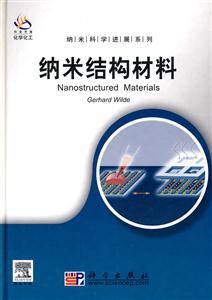-
>
公路車寶典(ZINN的公路車維修與保養秘籍)
-
>
晶體管電路設計(下)
-
>
基于個性化設計策略的智能交通系統關鍵技術
-
>
花樣百出:貴州少數民族圖案填色
-
>
山東教育出版社有限公司技術轉移與技術創新歷史叢書中國高等技術教育的蘇化(1949—1961)以北京地區為中心
-
>
鐵路機車概要.交流傳動內燃.電力機車
-
>
利維坦的道德困境:早期現代政治哲學的問題與脈絡
納米結構材料 版權信息
- ISBN:9787030269676
- 條形碼:9787030269676 ; 978-7-03-026967-6
- 裝幀:暫無
- 冊數:暫無
- 重量:暫無
- 所屬分類:>
納米結構材料 本書特色
《納米結構材料(導讀版)》主要特點:按納米材料功能進行章節劃分,將合成、表征和應用融為一體。介紹納米材料在新能源領域的應用,以及由其形成的多級結構和組裝體。由相關領域的知名專家共同編寫,涉及納米材料領域眾多研究熱點。適合從事納米材料、新能源等相關領域的研究人員參考。《納米結構材料(導讀版)》的目錄和編者均已譯成中文.正文保留英文原版。另附清華大學化學系李亞棟教授所作中立導讀一篇。
納米結構材料 內容簡介
本書立足于納米材料及其功能。
納米材料包括金屬、陶瓷、聚合物以及復合材料等。本書重點介紹了納米材料的功能,特別是短期內有應用前景的功能,例如催化、能量采集、能源存儲、光學性質以及通過自組裝實現的表面功能化。
此外,本書還討論了納米晶態材料和納米復合物,其內容涵蓋了這類新型工程材料的基本性質和要求。其中,穩定性、可靠性和機械性能是這類材料值得特別關注問題。
本書比較了合成上述納米材料的各種方法,并在統籌各章節的基礎上概述了納米技術的前景。
納米結構材料 目錄
1.納米功能材料——微觀結構、熱力學穩定性和原子遷移率
2.納米材料的可靠性
3.納米復合物材料的力學性能
4.用于低溫燃料電池的負載型納米催化劑
5.納米晶太陽能電池
6.用于氫氣和能源存儲的納米材料
7.具有多級結構的材料及其光學應用
8.納米顆粒在界面組裝形成高度有序的圖案化結構
索引
納米結構材料 節選
《納米結構材料(導讀版)》立足于納米材料及其功能。納米材料包括金屬、陶瓷、聚合物以及復合材料等。《納米結構材料(導讀版)》重點介紹了納米材料的功能,特別是短期內有應用前景的功能,例如催化、能量采集、能源存儲,光學性質以及通過自組裝實現的表面功能化。此外,《納米結構材料(導讀版)》還討論了納米晶態材料和納米復合物,其內容涵蓋了這類新型工程材料的基本性質和要求。其中,穩定性、可靠性和機械性能是這類材料值得特別關注的問題。《納米結構材料(導讀版)》比較了合成上述納米材料的各種方法,并在統籌各章節的基礎上概述了納米技術的前景。
納米結構材料 相關資料
插圖:As nanostructured materials are structures far away from thermodynamic equilibrium and since they have short transport pathways, fast diffusion and rapidtransformation kinetics often lead to coarsening and to the deterioration of themicrostructure and the associated properties. Thus, ensuring the stability of thenanoscale structures is a key issue. Aside from restricting the range of candidate materials to the class of refractories such as ceramics or high-melting pointmetals that are kinetically stabilized at or near ambient conditions, a compositeapproach involving either two nanosized phases or an extended polycrystallineor amorphous matrix and a nanocrystalline pore phase are obvious solutions forthe latter issue since the material transport required for coarsening is severelyhampered by a composite structure with limited mutual solubility. This routealso includes surface-functionalized nanoparticles as, for example, presented bymetallic nanoparticles with a shell consisting of organic ligands or of a naturaloxide of the metal [60]. However, it is inherent to nanocrystalline materials thatthe analysis of microstructure-property relations needs to consider internal interfaces rather than the surface of the nanoscaled structural units. Especially withtwo-phase nanocomposites, heterophase interfaces with the additional degree offreedom given by the position-dependent composition and possible concentration gradients need to be regarded. An important and basic aspect concerningthe functionality of a given material is presented by the respective phase equilibrium that determines the stable structure and the phase distribution and thus therelated materials properties. In fact, modifying the phase equilibrium by alloyingto improve the performance of a material has been the first and most successful step to modern materials science. However, the phase diagrams are mostlyunknown for nan
- >
名家帶你讀魯迅:故事新編
- >
我與地壇
- >
朝聞道
- >
煙與鏡
- >
月亮虎
- >
【精裝繪本】畫給孩子的中國神話
- >
姑媽的寶刀
- >
山海經















